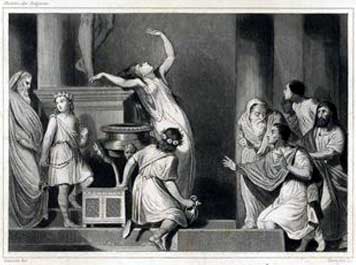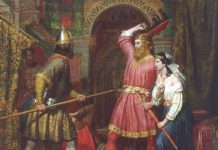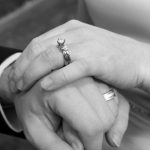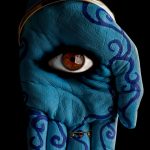Cleromancy is the method of divination that involves casting lots. It is one of the oldest forms of divination in the world and is even referenced in the Bible. In fact one of the prophecies surrounding the crucifixion of Christ centers around the soldiers at the crucifixion casting lots for his clothing. Almost all cultures have some sort of Cleromancy tradition; the Germanic tribes cast runes, the Chinese used I Ching. Anything can be used as a lot in cleromancy: pebbles, colored crystals, bones, sticks and in the modern day dice are most commonly used. Many cultures still engage in cleromancy as a form of divination.

Practicing Cleromancy
If you want to practice cleromancy with stones, you want to gather thirteen light colored or white pebbles or stones and thirteen black or dark colored stones or pebbles. Be sure they are similar in size and shape; you want them to be as indistinguishable from one another as possible. Ideally, they should also be smooth. Begin by asking a yes or no question. While you ask it, place the pebbles in a bowl or a small bag and shake them at least two times. Repeat the question a second time, then take a deep breath and repeat the question a third time. Close your eyes and reach into the bowl or bag and grab a handful of the stones. Carefully place them on a nearby surface like a table or the ground. Look and see if there are more white or more black pebbles. More white pebbles means the answer is yes and more black pebbles means the answer is no. If there are an even number of white and black pebbles then the answer is no, not right now and you will want to try casting lots with pebbles again later.
If you want to cast lots using dice you will need a pair of normal, ordinary dice. Make a list of twenty possible answers to a question and number them four through twenty-four. Take the two dice and cast them. Write the total number down unless one dice falls out of the bowl or off the table; the numbers on any dice that falls to the floor or out of the area where they were cast should be ignored. Cast the dice again and write those numbers down, then add them to the first number. The combination from the first cast and the second cast is the number of your answer. If all the dice roll off the table or out of the rolling area you should not perform any more casting or cleromancy that day.
The best days to perform casting lots are Monday, Tuesday, Wednesday, Thursday and Saturday. Sunday and Friday should never be used for casting. All the other days are considered favorable, but if you consistently drop the stones or the dice roll out of range you should stop casting on that day because conditions are not favorable.
Opon Ifa in Cleromany
An Opon Ifa is a tray used for divination in african religions, most particularly in Yoruba religious traditions. It is used by the diviner or Babalawo to communicate with the spirits in order to find out what problems there are, how they can be corrected, and to restore harmony with the spirits. They may be circular or rectangular, are flat and may be carved with figures or designs. The top of the tray is known as the head and the bottom known as the tail. Some Opon Ifa are created with depictions of the spirit known as Eshu who is believed to be the spirit who communicates with the Babalawo. The Opon Ifa is where the palm or kola nuts are cast so that the Babalawo can read them and determine which of 256 signs is displayed. Once they have determined which sign is being shown, they will chant a related verse.
Opon Ifa are used as a part of the Ifa religion and system of divination. The ‘holy book’ used in Ifa is known as the Odu Ifa. The Odu Ifa identifies Orunmila as the prophet or ‘Grand Priest’ who revealed the divinity and prophecy to the world. Ifa is practiced in the america’s, West africa and the Canary Islands, and plays an important and critical role in the traditions of religions including Santeria, Palo, Umbanda, and Vodou. In the religion as it is practiced by the Yoruba, Eshu lends ashe to the Babalawo so they can provide direction or clarification. He also holds the keys to the ire of an individual and he can grant or remove ire as he feels it is necessary.
While Eshu’s name is often mis-translated to be equitable to the Christian Satan, he is not. He most closely resembles a trickster, a minor god in charge of chance, accident and unpredictability. He gets something of a bad rap because spiritual novices tend to offer inappropriate tribute to Eshu and in return he will deal them a hand of misfortune. He is considered a divine messenger with the job of negotiating between the positive and negative forces in the body, and for carrying messages and sacrifices from humans to the Sky God. He has the ability to enhance the power of healing medicines. It is to Eshu that the babalawo is speaking when they recite a relevant Ifa and from Eshu they are hoping to receive guidance or answers that they can pass on to their petitioner.
There are sixteen books in Odu Ifa and when combined there are a total of 256 Odu; sixteen, each of which has sixteen alternatives that can be used. These 256 Odu are believed to be applicable to any situation a petitioner may come across, including circumstances, actions, and consequences. It’s important to understand that the Ifa proverbs are not written down. all 256 of them are passed down orally from one babalawo to another. In fact, the Ifa system of divination was added to the list of ‘Masterpieces of the Oral and Intangible Heritage of Humanity’ by UNESCO in 2005!















